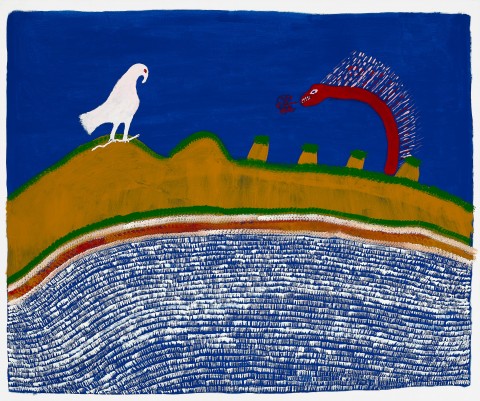ANGRY BULUKBUN, 1990
GINGER RILEY MUNDUWALAWALA
synthetic polymer paint on canvas
141.0 x 169.0 cm
bears inscription verso: artist's name, date and Alcaston Gallery cat. AK856
Painted at Borroloola, Northern Territory
Alcaston Gallery, Melbourne
Private collection, Melbourne
Mother Country In Mind: The Art of Ginger Riley Munduwalawala, National Gallery of Victoria, Melbourne, 16 July – 22 September 1997, cat. 28 (label attached verso)
Ryan, J., Ginger Riley, National Gallery of Victoria, Melbourne, 1997, p. 69 (illus.)
‘My mother’s country is in my mind.’1
Distinguished by their daring palette, dynamic energy and strongly flattened forms, Riley’s bold, brilliantly-coloured depictions celebrating the landscape and mythology of his mother’s country are admired among the finest in contemporary Indigenous art. Emerging at a time when barks were the familiar output for his Arnhem Land country and Papunya Tula paintings were considered the norm, his striking interpretations not only challenged, but irrevocably changed, preconceived notions of Indigenous art – thus earning him the moniker ‘the boss of colour’ by artist David Larwill. Notably influential upon such idiom was Riley’s chance encounter during his adolescence with celebrated watercolourist Albert Namatjira, whose non-traditional aesthetic and concept of ‘colour country’ left an indelible impression upon the young artist. Encouraged by ‘…the idea that the colours of the land as seen in his imagination could be captured in art with munanga (white fella) paints’,2 it was not, however, until three decades later that Riley would have the opportunity to fully explore his talent when the Northern Territory Open College of TAFE established a printmaking workshop in the Ngukurr Aboriginal Community (formerly known as the Roper River Mission). Notwithstanding his mature age of 50, Riley rapidly developed his own highly sophisticated style and distinct iconography and, after initially exhibiting with the other Ngukurr-based painters, soon established an independent career at Alcaston Gallery. Enjoying tremendous success both locally and abroad over the following sixteen years before his untimely death in 2002, Riley received a plethora of awards including the inaugural National Heritage Commission Aboriginal and Torres Strait Islander Art Award in 1993 and an Australia Council Fellowship in 1997 – 98, and in 1997, was the first living indigenous artist to be honoured with a retrospective at the National Gallery of Victoria, Melbourne.
Significantly exhibited in this ground-breaking retrospective, Angry Bulukbun, 1990 offers a stunning example of Riley’s heroic landscapes inspired by his mother’s country – specifically, the saltwater area extending from the coast of the Gulf of Carpentaria along the Limmen Bight River to the weather-worn rocky outcrops known as the ‘Four Archers.’ Pivotal to the composition is Ngak Ngak, the white-breasted sea eagle depicted in profile who plays the role of sentinel or guardian protecting the country, and on the right, the powerful creator-snake Garimala who is here dramatically transformed into the fierce, fire-breathing serpent-dragon named Bulukbun. According to the ancestral dreaming, this mythological Taipan created the Four Archers – an area regarded as ‘…the centre of the earth, where all things start and finish’3 – and lives in the waterhole nearby. If elsewhere in Riley’s oeuvre Garimala is depicted as a pair of snakes (a typical convention to denote his travelling) or a rainbow (symbolic of water, the seasons and the life cycle), when portrayed in the guise of Bulukbun, he is invariably angry, as illustrated by the expanding scaly spines on his back and his fiery breath. Indeed, as the artist notes, the more aggressive Bulukbun becomes, the more he raises the spines on his back, while his forked tongue and the deadly flames he expels (or streams of bubbles if he is underwater, as pictured here) are a strong warning to all to keep their distance.4
Like the best of Riley’s achievements, the present embodies magnificently the artist’s powerful vision of his mother’s country as a mythic space – a mindscape whose kaleidoscope of dazzling colours and icons continually evokes wonder and mystery in the viewer with each new encounter.
1. Riley cited in Ryan, J., Ginger Riley, National Gallery of Victoria, Melbourne, 1997, p. 15
2. Riley cited ibid.
3. Riley cited ibid., p. 29
4. Riley cited ibid., p. 31
VERONICA ANGELATOS
